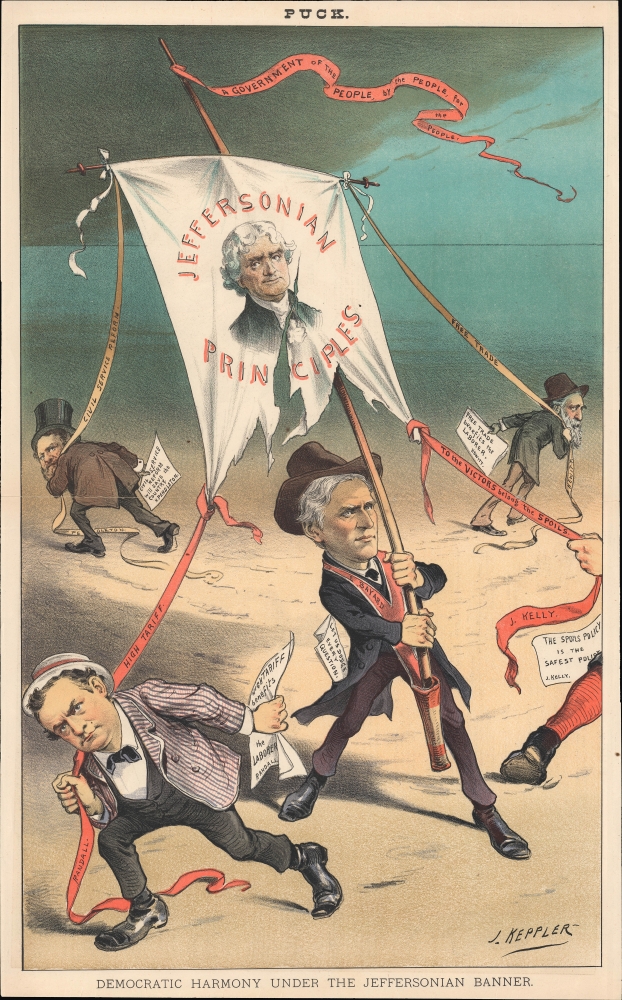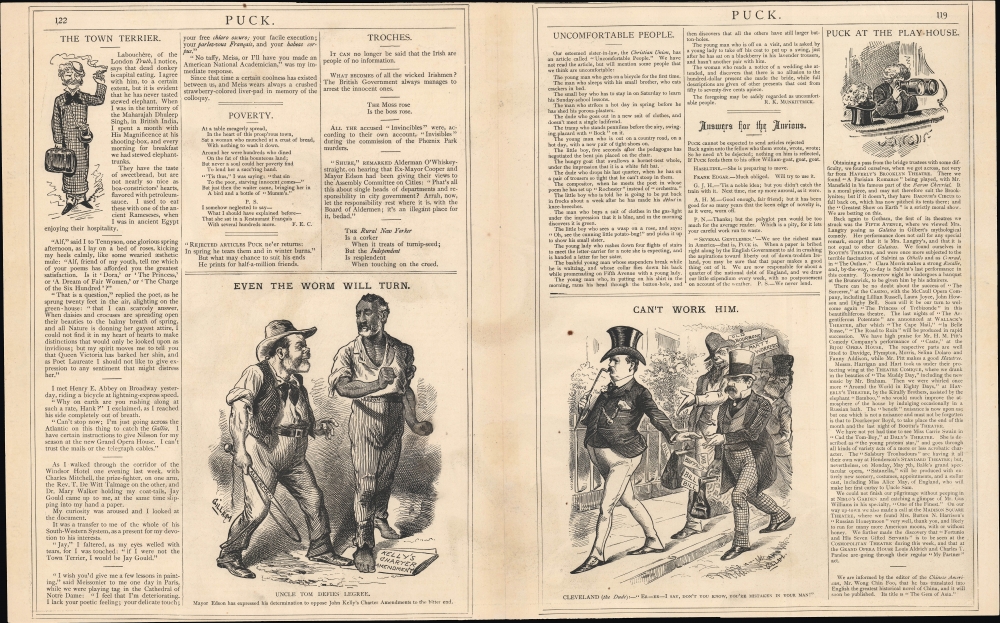1883 Keppler Satirical Cartoon of Democratic Party Infighting
JeffersonianPrinciples-keppler-1883
Title
1883 (undated) 19.5 x 11.75 in (49.53 x 29.845 cm)
Description
A Closer Look
This satirical cartoon lampoons the predicament of the Democratic Party at the time, deeply divided over the issues of trade and civil service reform. At left, George H. Pendleton, a Democratic Senator from Ohio, pulls the party towards civil service reform. He had been instrumental in getting a law through Congress that instituted a professional bureaucracy and ended the 'spoils system,' which rewarded party loyalists and donors with government jobs. Opposing him at right is John Kelly, who was the face of Tammany Hall at the time and had rebuilt the political machine after the downfall and death of William 'Boss' Tweed. Ironically nicknamed 'Honest John,' Kelly was very wealthy and extremely powerful in New York City, though he clashed frequently with Samuel Tilden, another Tammany Hall leader, and with a string of mayors of New York (who were elected every year at the time). Kelly vociferously opposed Grover Cleveland (Governor of New York and a Tilden ally) as the Democratic Party's candidate at the 1884 convention, in large part because Cleveland ran on a platform of anti-corruption.The issue of trade also divided the Democratic Party, with Samuel Randall, recently the Speaker of the House, representing the pro-tariff wing of the party. This position was at odds with most of the party and cost Randall a second stint as Speaker when the Democrats regained the House in 1883. Randall supported Cleveland, who was initially ambiguous on tariffs, for president, but later opposed his efforts to reduce tariffs; by the end of his career, Randall was considered as a Republican in all but name. Opposite Randall is Abram Hewitt, a former Mayor of New York City and representative in the U.S. Congress for New York's 10th District, which included New York City. Hewitt was himself an entrepreneur and financier, who favored reducing tariffs to promote economic growth.
At center, Thomas Bayard holds up a banner of Thomas Jefferson that is being torn in two, while the third president's face wears a look of consternation. Bayard was an influential U.S. Senator from Delaware who had unsuccessfully ran for the Democratic nomination for president in 1876 and 1880 and was considered a leading candidate for the 1884 election. In the end, however, he was hamstrung (as in 1876 and 1880) for a speech he had made at the outset of the American Civil War (1861 - 1865) advocating for Delaware's neutrality, and for his general sympathy with the South during Reconstruction.
Two cartoons on the verso continue the theme of Democratic Party politics, with one at left using a scene from Uncle Tom's Cabin as a metaphor for battles between New York City's Mayor Edson (an anti-Tammany Democrat) and Kelly, and the one at right simultaneously extolling and poking fun at Grover Cleveland's famous incorruptibility.
Chromolithography
Chromolithography, sometimes called oleography, is a color lithographic technique developed in the mid-19th century. The process involved using multiple lithographic stones, one for each color, to yield a rich composite effect. Oftentimes, the process would start with a black basecoat upon which subsequent colors were layered. Some chromolithographs used 30 or more separate lithographic stones to achieve the desired product. Chromolithograph color could also be effectively blended for even more dramatic results. The process became extremely popular in the late 19th and early 20th centuries, when it emerged as the dominant method of color printing. The vivid color chromolithography produced made it exceptionally effective for advertising and propaganda imagery.Publication History and Census
This political cartoon was drawn by Joseph Keppler and published in the April 25, 1883, issue of Puck Magazine. Although widely published, specific issues of Puck are scarce and hard to find on the private market. They are also poorly cataloged in institutional collections, so it is difficult to know how many of each issue survive. The present cartoon is only independently cataloged by the Library of Congress.Cartographer
Joseph Ferdinand Keppler (February 1, 1838 - February 19, 1894) was an immensely influential Austrian-born American caricaturist and cartoonist. Born in Vienna, Keppler studied art at the Academy of Fine Arts Vienna and contributed work to the Vienna-based comedy magazine Kikeriki. As he was unable to support himself only with his art, Keppler joined a theatrical troupe and acted as its scene painter and then as a comedian. He earned some extra money as the troupe traveled through the Tyrol and Italy by restoring old paintings in monasteries. He married Viennese actress Minna Rubens in 1864 and he and his wife soon emigrated to the United States to join Keppler's father, who had emigrated to the United States to escape the Revolutions of 1848 and was the proprietor of a general store in northern Missouri. By 1867, Keppler and his wife had settled in St. Louis, where Keppler was working as an actor. He helped start the German-American cartoon weekly Die Vehme in 1869. Die Vehme survived for a year, and was followed by Frank und Frei, which lasted only six months. Keppler founded Puck in St. Louis in March 1871, though this iteration of the magazine only lasted until August 1872. Minna died in 1870, and Keppler married Pauline Pfau in 1871, with whom he had three children. Keppler and his wife moved to New York City in 1872, where he found work in Frank Leslie's publishing house, and Keppler began contributing cartoons to Frank Leslie's Illustrated Newspaper in 1874. Puck was restarted by Keppler and fellow Frank Leslie employee Adolph Schwarzmann in September 1876 for the German-American population in New York, and began printing an English-language edition the following year. Keppler's cartoons, particularly those criticizing President Ulysses S. Grant and his administration, began to generate attention and publicity for the magazine. Keppler's caustic wit and clever adaptations of classical and historical subjects became famous, as did their pioneering use of color lithography. Keppler published a special World's Fair Puck from the World's Columbian Exposition in Chicago during the summer of 1893, a strain that took a terrible toll on his health, and contributed to his death the following year in New York. More by this mapmaker...




